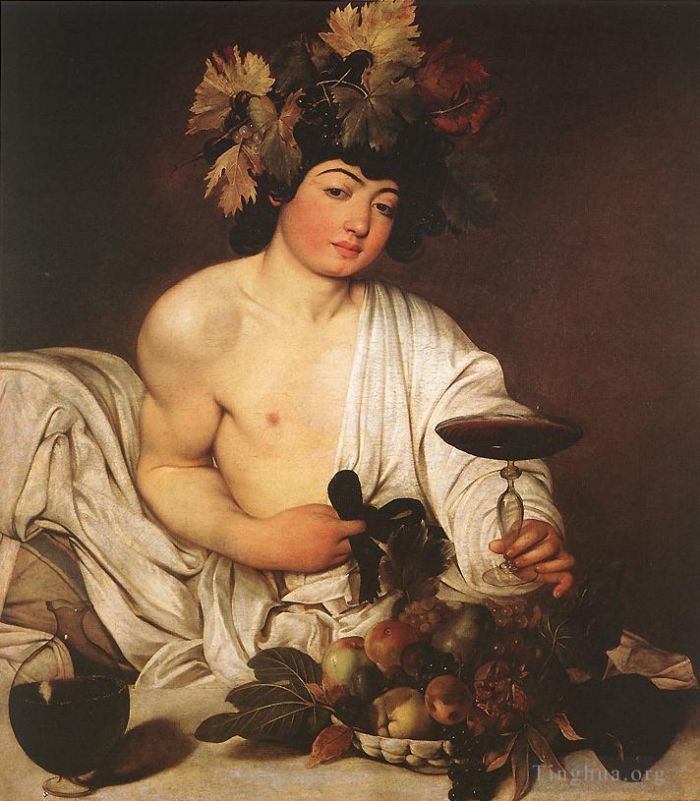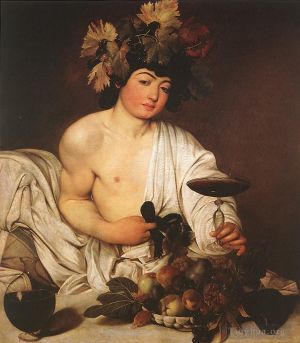Bacchus
Caravaggio
- Price: Price on Request
- Art Type: Oil Painting
- Size:
- English Comments: 0
- International Comments: 0
- Creating Date:
- Introduction and Works of Caravaggio >>
Keywords:
Bacchus
Work Overview
- Bacchus
Italian: Bacco
Artist Caravaggio
Year c.1595
Medium oil on canvas
Dimensions 95 cm × 85 cm (37 in × 33 in)
Location Uffizi, Florence
Bacchus (c. 1595) is a painting by Italian Baroque master Michelangelo Merisi da Caravaggio (1571–1610). It is held in the Uffizi Gallery, Florence.
The painting shows a youthful Bacchus reclining in classical fashion with grapes and vine leaves in his hair, fingering the drawstring of his loosely draped robe. On a stone table in front of him is a bowl of fruit and a large carafe of red wine; with his left hand he holds out to the viewer a shallow goblet of the same wine, apparently inviting the viewer to join him.
Bacchus was painted shortly after Caravaggio joined the household of his first important patron, Cardinal Del Monte, and reflects the humanist interests of the Cardinal's educated circle. It was not in the cardinal's collection at his death, and may have been a gift to the Grand Duke in Florence. It was unknown until 1913.[1] When it was found in a storeroom of the Uffizi Galleries, it had never been catalogued or framed.[2]
Bacchus' offering of the wine with his left hand, despite the obvious effort this is causing the model, has led to speculation that Caravaggio used a mirror to assist himself while working from life, doing away with the need for drawing. In other words, what appears to us as the boy's left hand was actually his right. This would accord with the comment by Caravaggio's early biographer, the artist Giovanni Baglione, that Caravaggio did some early paintings using a mirror. English artist David Hockney made Caravaggio's working methods a central feature of his thesis (known as the Hockney-Falco thesis) that Renaissance and later artists used some form of camera lucida. The model for Bacchus might have been Caravaggio's friend Mario Minniti, whom he had used before in The Musicians.[3]
It was discovered upon closer investigation that Caravaggio included a miniature self portrait of himself painting the subject in the reflection of the offered glass.
----------
Michelangelo Merisi, called Caravaggio, is one of the most important artists in the history of Art.
Nervous by temperament, often violent, revolutionary in his way of painting, Caravaggio personifies in every aspect of his eventful life the romantic figure of the damned artist.
Born in Milan, he worked mainly in Rome, Naples, Malta and Sicily. His training was strongly influenced by Venetian and Lombard painting: from the first, he learned the use of the color, from the second, he learned the deep realism and the preference for humble and popular subjects.
This last feature is observable in the famous Bacchus conserved at the Uffizi, commissioned by his patron Cardinal del Monte as a gift for the Grand Duke of Tuscany Ferdinand I and painted between 1596 and 1597.
In this masterpiece, Bacchus is not represented in an idealized way. On the contrary, he might look like a man of the people, like one of those characters Caravaggio used to hang around with in taverns and brothels. As in the majority of his paintings, the landscape is missing: the artist wants to focus on the humanity of the character rather than superfluous details. His choice of representing popular, uncouth and clumsy subjects brought him much criticism during his life.
Bacchus is depicted posing and holding a cup of wine with his left hand, as if he was reflected in a mirror. In fact, Caravaggio used a complex system of mirrors to paint the subjects on canvas, just like a primitive photographic technique. Outstanding is the skillful use of the oil technique: the effect of incredible realism in painting the fruit basket and the complexion of the young man as well as the transparency of the glass created a new approach to art.
A recent restoration has revealed the outline of a man’s face in the jug of wine in the foreground that is believed to be the self-portrait of the artist.
Unconventional, introspective and a real rebel, Caravaggio focuses on the human being, describing the imperfections and limitations of his mortal nature.
His way of painting upset forever the course and history of art.
--------------------
Bacchus by Caravaggio is an oil on canvas painting painted by Michelangelo Merisi da Caravaggio. Completed in about 1595 A.D., it is an example of the Renaissance era’s interest in Classical revival. It was painted during Caravaggio’s stay with his first patron, Cardinal del Monte.
Description
A young, dark-haired man clad only in a loosely draped robe offers an ornate glass goblet of red wine with his left hand. His right grasps a black cord that appears to secure his robe. In front of him is a bowl of fruit; to the viewer’s left is a round carafe of red wine.
Technique
Caravaggio was a young man when he painted this work, and scholars speculate that he may have been the model as well as the artist. He may have painted as a self-portrait directly from a mirror, or he may have used some early form of a camera lucida, a reflecting device that allows the artist to see subject and canvas simultaneously.
While the painting is not strictly chiaroscuro, its pale-skinned main figure highlighted against a darker background with stark shadows foreshadows his later dramatic use of chiaroscuro and tenebrism. Caravaggio further played with light in Bacchus by including reflections. A reflection of Bacchus can be found both in the carafe and in the wine in the goblet in his hand.
Innovation and Symbolism
Caravaggio advanced the realist, humanistic style of painting that the later Renaissance perfected. His Baccus is not portrayed as a perfect saint but rather as a drunken teenager with dirty fingers in front of a bowl of half-rotten fruit. The rotten fruit is thought to be a symbol of the transience of life. The Bacchus figure, portrayed by Caravaggio as a dissolute youth, illustrates the artist’s interest in naturalism.
Bacchus is a fine example of Caravaggio’s early work. Part portrait, part allegory, and part still life, centuries later it still rouses debate and captures the viewer’s imagination.
--------------------
In order to understand the historical position of Caravaggio's art, we have to be aware of his peerless and revolutionary handling of subject matter. This is true not only of his religious themes, but also of his secular themes. As with the earlier treatment of this subject, his Bacchus no longer appears like an ancient god, or the Olympian vision of the High Renaissance and Mannerism. Instead, Caravaggio paints a rather vulgar and effeminately preened youth, who turns his plump face towards us and offers us wine from a goblet held by pertly cocked fingers with grimy nails. This is not Bacchus himself, but some perfectly ordinary individual dressed up as Bacchus, who looks at us rather wearily and yet alertly.
On the one hand, by turning this heathen figure into a somewhat ambiguous purveyor of pleasures, Caravaggio is certainly the great realist he is always claimed to be. On the other hand, however, the sensual lyricism of his painting is so overwhelming that any suspicion of caricature or travesty would be inappropriate.
Nevertheless, Caravaggio's treatment of this subject clearly intends to present to the viewer a picture of a rather drunk young man, who is past any enjoyment of what he is drinking.
- Copyright Statement:
All the reproduction of any forms about this work unauthorized by Singing Palette including images, texts and so on will be deemed to be violating the Copyright Laws.
To cite this webpage, please link back here.
- >> English Comments
- >> Chinese Comments
- >> French Comments
- >> German Comments
- >>Report
- Saint Jerome in Meditation
- Still Life with Flowers and Fruit
- The Musicians
- St John the Baptist Youth with Ram
- Supper at Emmaus
- Madonna and Child with St Anne
- Flagellation
- The Sacrifice of Isaac
- Young Sick Bacchus
- Nativity with St Francis and St Lawrence
- Portrait of Alof de Wignacourt1
- St John the Baptist
- The Sacrifice of Isaac2
- The Conversion of St Paul
- David with the Head of Goliath
- The Crucifixion of Saint Peter
- St John the Baptist1
- Narcissus
- Medusa
- Beheading of Saint John the Baptist
- The Martyrdom of St Matthew
- Boy with a Basket of Fruit
- The Denial of St Peter
- Salome with the Head of the Baptist
- Portrait of Alof de Wignacourt2
- St John the Baptist2
- St Francis1
- Saint Jerome Writing (Saint Jerome in His Study or simply Saint Jerome)
- Adoration of the Shepherds
- St Francis2
- Sleeping Cupid
- Saint Jerome Writing
- Christ in the Garden
- Jupiter Neptune and Pluto
- St John the Baptist at the Well
- Portrait of Maffeo Barberini
- The Crucifixion of St Andrew
- David with the head of Goliath
- Portrait of a Courtesan
- The Crowning with Thorns2
- Burial of St Lucy
- St Matthew and the Angel
- Boy Peeling a Fruit
- Ecce Homo
- The Seven Acts of Mercy
- The Entombment
- St Francis in Ecstasy
- The Inspiration of Saint Matthew
- Lute Player
- Judith Beheading Holofernes
- St John the Baptist
- The Incredulity of Saint Thomas
- The Fortune Teller
- The Tooth Drawer
- St Catherine of Alexandria
- Basket of Fruit still life
- David with the Head of Goliath
- The Crowning with Thorns
- Bacchus
- The Calling of Saint Matthew
- Boy Bitten by a Lizard
- The Raising of Lazarus
- Salome with the Head of St John the Baptist
- Magdalene
- The Conversion on the Way to Damascus
- Rest on Flight to Egypt
- The Fortune Teller
- The Lute Player
- The Annunciation
- Taking of Christ
- Amor Victorious
- Madonna di Loreto
- Christ at the Column
- The Death of the Virgin
- The Martyrdom of St Ursula
- Madonna del Rosario
- The Cardsharps
- Supper at Emmaus
- Martha and Mary Magdalene









 Singing Palette
Singing Palette